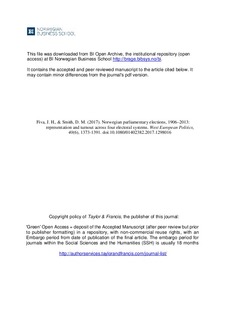| dc.contributor.author | Fiva, Jon H. | |
| dc.contributor.author | Smith, Daniel M. | |
| dc.date.accessioned | 2019-02-28T12:01:56Z | |
| dc.date.available | 2019-02-28T12:01:56Z | |
| dc.date.created | 2017-11-30T15:04:30Z | |
| dc.date.issued | 2017 | |
| dc.identifier.citation | West European Politics. 2017, 40 (6), 1373-1391. | nb_NO |
| dc.identifier.issn | 0140-2382 | |
| dc.identifier.uri | http://hdl.handle.net/11250/2588036 | |
| dc.description.abstract | Since gaining full independence in 1905, Norway has experienced more than a century of democratic elections, and has reformed its electoral system three times, most notably with the switch from a two-round runoff system to proportional representation in 1919. This research note introduces a new dataset featuring all candidates running for parliamentary (Storting) elections from 1906 to 2013, and documents the patterns over time and across electoral systems in the development of the party system; candidates’ gender, age, occupation, and geographic ties; and voter turnout. Scholars interested in using the dataset can gain access to it through the Norwegian Centre for Research Data | nb_NO |
| dc.language.iso | eng | nb_NO |
| dc.publisher | Taylor and Francis | nb_NO |
| dc.subject | Representation | nb_NO |
| dc.subject | Electoral Systems | nb_NO |
| dc.subject | Turnout | nb_NO |
| dc.title | Norwegian parliamentary elections, 1906?2013: representation and turnout across four electoral systems | nb_NO |
| dc.type | Journal article | nb_NO |
| dc.type | Peer reviewed | nb_NO |
| dc.description.version | acceptedVersion | nb_NO |
| dc.source.pagenumber | 1373-1391 | nb_NO |
| dc.source.volume | 40 | nb_NO |
| dc.source.journal | West European Politics | nb_NO |
| dc.source.issue | 6 | nb_NO |
| dc.identifier.doi | 10.1080/01402382.2017.1298016 | |
| dc.identifier.cristin | 1521056 | |
| cristin.unitcode | 158,3,0,0 | |
| cristin.unitname | Institutt for samfunnsøkonomi | |
| cristin.ispublished | true | |
| cristin.fulltext | postprint | |
| cristin.qualitycode | 2 | |
